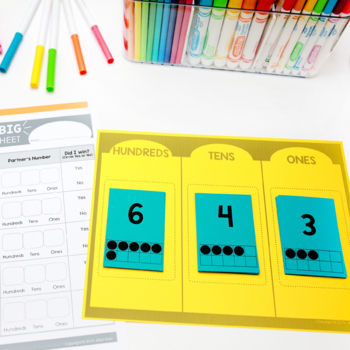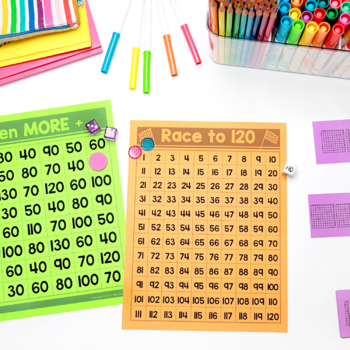Place Value Math Centers | Activities and Games for Hundreds, Tens and Ones
- PDF
What educators are saying
Also included in
- THIS IS A BUNDLED SET OF ALL MY 2ND GRADE MATH ACTIVITIES! Buy them together for 25% less than if you bought them separately!INCLUDED IN THIS BUNDLE:2 Digit Addition and Subtraction with Regrouping Mega Pack2 Digit Addition and Subtraction with Regrouping Centers is packed with engaging activities fPrice $49.50Original Price $65.50Save $16.00
Description
Place Value Bundle: 55 pages of Common Core aligned Place Value games, activities, posters and work pages to teach hundreds, tens and ones to your students.
Place value, or understanding that numbers are composed of hundreds, tens and ones, is a fundamental concept, forming the basis for work with larger numbers. This series of place value games, activities and work pages provides you with 55 pages of resources to teach and support student’s understanding of place value and our base-10 number system.
••••••••••••••••••••••••••••••••••••••••••••••••••••••••••••••••••••••••••••••••••••
Place Value Resources Included in this Product:
• Race to 500: This game introduces the idea of gathering tens and exchanging them for hundreds until you reach 500 (or 5 “hundreds”). This game uses a mat to illustrate place value, with visual models of tens and hundreds.
• Race to 119/Race to 120: These games teach students the idea of 10 more, 10 less, 1 more and 1 less. Depending on your school’s math program, you can choose either a 120-chart or a 119-chart for your students.
• Making It Big: This game strengthens the understanding of place value. Students learn that a 2 in the “ones place” plays a very different role than a 2 in the “tens place” or “hundreds place”. It also asks students to examine a pair of 3-digit numbers and determine which is greater.
• Set of 10-frame playing cards (Numbers 0-9)
• Roll, Build & Write: Asks students to roll 3 dice (representing the hundreds, tens and ones place). Students then build their number with hundreds, ten-rods and ones. Finally, students are asked to represent their picture with a math sentence.
• Ten More: This popular math game asks students to practice mentally adding 10 to a two or three digit number.
• Missing pieces: Asks students to fill in missing numbers from either a 120-Chart or a 119-Chart, depending on your math curriculum.
• Set of 24 playing cards: Pairs of cards, one with numbers written numerically, and the other illustrated with hundreds, ten-rods and ones. (Can be used to play memory, war or Go Fish!)
• Hundreds, Tens and Ones Place Value Mat (can be used to reinforce any activity)
• Ten More/Ten Less: Students roll a dice to determine their starting number (a 5 represents 50) and then practice with +10, +20 and -10.
• Set of 24 “I have”/”Who has?” Cards: A Hundreds, Tens & Ones version of this well known game helps students practice counting “tens and some more” with visuals.
• More & Less: Work Page that asks students to practice adding/subtracting 10 and 100 from given numbers.
• Hundreds, Tens & Ones: Work Page that asks students to write the numerical value represented by the hundreds, ten-rods and ones.
• More & Less: 4 Work pages that provides a visual representation of adding and subtracting ten and adding and subtracting one. Students use the visual format of the 0-119 chart or 1-120 to help them identify the “neighbors” of the given numbers. 2 work pages are provided to use with the 0-119 chart, and 2 more are provided to use with the 1-120 chart (depending on your curriculum).
• 0-119 Chart (for student reference)
• 1-120 Chart (for student reference)
••••••••••••••••••••••••••••••••••••••••••••••••••••••••••••••••••••••••••••••••••••
OTHER MATH PRODUCTS THAT MAY INTEREST YOU:
Addition and Subtraction Mega Pack
Tens & Ones Bundle-Common Core Aligned Games, Activities, Posters & Work Pages
Coin Counting Club- Money Math Center Bundle
Coin Counting Club- Money Math Center Bundle (Canadian Version)
Kindergarten Math Journal Prompts
© Jillian Starr 2013
This product is intended for personal use in one classroom only. For use in multiple classrooms, please purchase additional licenses.






